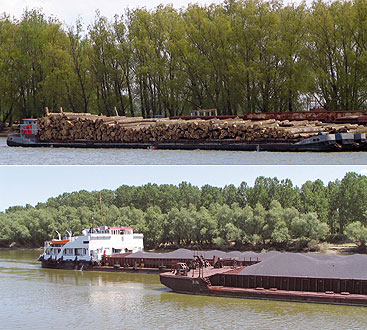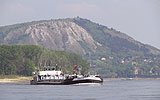Finding room for navigation and the environment

Finding room for navigation and the environment
Inland waterway transport can be an environmentally friendly alternative to road or rail transport, and contributes to the decongestion of the overloaded road network in densely populated regions. Can sustainable waterway infrastructure projects create win-win solutions for the environmental needs of the river?

Before the Danube can handle more traffic, the EC argues that bottlenecks – barriers that prevent year-round passage – need to be eliminated. Not everyone agrees, however, mainly because of fears of environmental damage. WWF has been active for years campaigning against changing the river to accommodate shipping traffic, arguing instead that the interests of the river should come first. WWF found that most of the bottlenecks identified by the EC were in ecologically outstanding areas, some of the last remaining natural areas along the Danube and many with high levels of nature protection.
Inland navigation can contribute tomaking transport more environmentally sustainable, particularly where it substitutes for road transport. it can, however, also have significant influence on river ecosystems, jeopardising the goals of the EU Water Framework Directive, which aims for the ‘good ecological status’ of all waters by 2015.
Economic growth is linked to investments in infrastructure; to improve cross-country transportation, the European Commission (EC) has therefore developed the Trans-European Transport Network (TEN-T) with guidelines and financing for Pan-European road, rail, air and waterway transportation corridors. The Danube has been identified as Corridor VII.
Otto Schwetz, Chairman of the Pan-European Transport Corridor VII and President of the International Navigation Association Section Austria, speaks to journalist Natasha Christl about how to reconcile what might be conflicting interests.
Christl: Are the needs of navigation and the environment
always at odds?
Schwetz: I am convinced that all countries in the Danube
region have the right to have access both to the
Black Sea and to the Danube itself, whether through a
port, canal or some other channel. On the other hand,
there are rules governing the protection of the environment
around the Danube, and those rules must be
observed. That is why we support inland navigation:
because it is the cleanest mode of transport. But in
order to use inland navigation, we need the means of
doing so. This can be a problem.
Christl: Such as the controversial work on the deepwater
navigation canal in the Bystroe Branch of the
Danube Delta…
Schwetz: The Bystroe arm is a very short branch of
the Danube, which is a good thing in that it provides a
short route to the sea. But the delta is a very sensitive
area in need of protection. It is one of the few remaining
natural areas that we have. The wildlife in the area is
terrific, as is the fauna.
Ukraine made a mistake in failing to consult the Romanian authorities and agree on the conditions for the construction of the canal, as required by international norms. It should have invited the Romanian authorities and international experts to visit the site and see for themselves what was being done.
The bysTroe canal
Much of the national and international controversy
surrounding this project arises from its location.
The Danube Delta, spanning the border between
Romania and Ukraine, includes UNESCO Biosphere
Reserves and a World Natural Heritage site. It is
a wetland rich in plants (over 1,000 species), birds
(300 species, including the largest pelican colony
in Europe) and fish (including several endangered
species of sturgeon).
Work is being undertaken to deepen and modernize a canal that was in use until the 1950s. The Bystroe Canal would aid navigation through the Danube Delta, and would increase inland shipping by more than 60%, according to a 2003 feasibility study.
However, the Inquiry Commission of the United Nations Economic Commission for Europe (UNECE) issued a report in 2006 concluding that the Bystroe Canal will have “significant adverse transboundary effects” on the environment and should be stopped until the ecological consequences could be properly evaluated.
Christl: So it is important to consider all stakeholders
and their needs in the planning stage?
Schwetz:We have to take into consideration that people
need some way of making a living. A major problem
is the difference in fees charged for passing through
the navigation waterways in both parts of the Danube
Delta, Romanian and Ukrainian. The Bystroe canal is
much cheaper than Romania’s waterways. There should
have been a conference between the EU, Corridor VII, Ukraine and Romania to consider how to handle that
problem. The question as to how the system should be
organised is crucial, and one that should be addressed
by the port authorities.Who does what?Which vessels
should use which waterway? Constanza is a main port
and the main entrance to the Black Sea, but the other
ports are also important.We must find a way to improve
navigation together, to decide on the kind of vessels
that use the existing canals and to use the Danube in
the best possible way.
This is why the ICPDR and the Danube Navigation Commission and the International Sava Commission under participation of Corridor VII issued a ‘Joint Statement on Inland Navigation and Environmental Sustainability in the Danube River Basin’, setting out mechanisms for the development of the infrastructure for inland navigation and addressing ways in which to overcome such problems, especially the common way to start new projects. The statement was a response, among other things, to the Bystroe Canal. I think that both Ukraine and Romania must now hold direct bilateral consultations on how to handle the problem; if they can’t reach agreement, perhaps the EU should help. The ICPDR should adopt a tough stance in any such consultations. And I think that if both sides are willing to do what is best for the region, then that is the best way forward.
Christl: Should measures be proposed
to compensate for damage
caused by the construction and
maintenance of the canal?
Schwetz: In Vienna we are very
familiar with the idea of compensatory
measures; for example, if
trees over a certain size are cut
down in a public park or a private
area, there is a legal requirement
that those trees must be replaced.
I think that that is a good thing,
provided that compensatory measures
are reasonable.

While a navigable fairway is necessary as a transport ‘artery’ – not only for Ukraine but for the whole of the EU – the whole area must be protected. Something must be offered in compensation in order to provide that protection. It is also important to make Ukraine a greener country and promote its green image. Many parts of Ukraine are industrial and suffer from widespread land pollution and other problems. While some efforts are being made to address those problems, much more must be done. I should add that the Ukrainian authorities have taken certain measures, but they are not enough.
Christl: What should the
compensatory measures
include?
Schwetz: Discussions between
the ICPDR, Ukraine
and Corridor VII are needed
on the kind of compensation
that could be offered. It is
important to handle the issue
with a clear understanding
of what is possible and what
is not.
The restoration and rehabilitation of wetlands and abandoned agricultural polders and fish ponds could also be a very good idea; this should be carried out. The restoration of the Lower Danube lakes is also important, since the lakes are in a beautiful area that should be protected. The public should be able to use and enjoy the area, although there should of course be certain limitations as to the extent to which it is used. The area should not be exclusively used by a small and privileged group, or by experts and scientists. The public should have an opportunity to get close to nature.
manual on good PracTices in susTainable
WaTerWay Planning
In September, the PLATINA consortium launched an innovative manual presenting good practices in sustainable waterway planning. This document, produced by the ICPDR Secretariat, illustrates how waterway development projects can be made compatible with environmental protection requirements, such as stipulated by EU law.
The manual offers general advice for waterway infrastructure projects and addresses both technical planners and interested stakeholders who want to be involved in a planning process. The early integration of stakeholders (including those representing environmental interests) and environmental objectives, with decisions communicated as widely as possible, are essential for a successful planning process.
The Manual was prepared within the EU PLATINA project, involving 22 organisations in 9 countries to improve inland waterway transport. The ICPDR work is based on two years of intense expert reflections with the Austrian waterway company via donau, the BOKU University of Natural Resources and Life Sciences as well as Inland Navigation Europe.
Christl: What would be needed to implement this idea?
Schwetz: I think we should hold a conference with
representatives from the ICPDR, Ukraine, Romania,
Corridor VII and the Directorate General for Environment
of the EU, perhaps in Brussels, Odessa or Vienna,
to discuss the next steps, because implementation will
take time. Some research should be carried out beforehand.
We should draw up a step-by-step programme in
order to achieve the aims we discussed earlier.
This should be discussed by the international organisations concerned, the European Commission and the Ukrainian and Romanian authorities. This will also foster good neighbourliness. Ukraine and Romania are already implementing a joint project in Bukovina; the regions of Suchava and Chernivzi are working together across the border, provided that there is sufficient political will. However, I think that the two countries need international organisations as partners; they need support and funding.
We have had a good experience with the joint Austrian– Slovakian border commission, which focuses on waterrelated issues; I think Ukraine and Romania should establish a similar body, but under the supervision of the EU and the ICPDR. While Ukraine is not an EU member, it borders the EU region and could benefit from many existing EU programmes.





